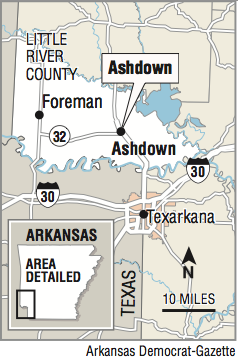A railroad crossing in Ashdown with no guards or warning devices is the fourth most dangerous in the country for wrecks, sometimes fatal, at the crossing over the past 10 years, according to the U.S. Department of Transportation's Federal Railroad Administration.
The agency ranked more than 200,000 crossings based upon the number of accidents, injuries and fatalities, said Matthew Lehner, an administration spokesman. Four railroad crossings in Phoenix -- all within a 2-mile range of one another -- are considered four of the worst five in the country.
The Kansas City Southern rail crossing on South Park Avenue off U.S. 71 in Ashdown has seen four fatalities, four injuries and 16 accidents since 2006, the administration reported. Motorists cross two sets of tracks at the intersection.
"It's a bad crossing," Ashdown city administrative assistant Debbie Garland said. "If you want to go to any business or restaurant in town, you have to go across tracks."
Railroad officials and city leaders have recently discussed the need for crossing guards at the intersection, but no deadline for the work is set, Garland said. A crossing at West Main Street near downtown Ashdown features lights and guards.
The design of the Park Street crossing may cause some of the accidents, officials said. Motorists who turn off U.S. 71 and onto Park Street have to slow quickly while crossing the tracks to negotiate a turn in the road. When approaching U.S. 71 from the crossing, there is only enough room for one car to stop between the roadway and tracks. Other cars often line up behind a vehicle waiting to turn onto U.S. 71, stopping on the crossing.
Carol Stockman, owner of Jim's Place, a restaurant across U.S. 71 from the railroad crossing, said she often sees near-collisions when motorists try to "beat the train."
"I'm looking out there right now," Stockman said Monday afternoon. "I can see a truck sitting on top of the tracks now. People are always in a hurry. You can see the train coming for a long while and you can hear it. If you sit in my building, you can hear the train like it's running through. You can't miss it.
"They don't think the trains are coming that fast, but they are."
The Federal Railroad Administration's release of the dangerous crossings came after its administrator, Sarah Feinberg, wrote to transportation officials in all 50 states informing them of available funds for crossing repairs.
"I urge you to join [Federal Railroad Administration] and take additional actions to improve crossing safety," Feinberg wrote in her letter. "I know that, together, we can do more to save lives."
She said Congress has approved a one-time increase in funding for the Section 130 Program, which helps pay for annual repairs to railroad crossing grades, of $350 million for the fiscal year 2016.
Ed Greenberg, a spokesman for the Association of American Railroads in Washington, said the rail industry welcomed the federal agency's attention on railroad crossing improvements.
"Grade-crossing safety is one of the freight-rail industry's biggest concerns as it is an important community issue," he said. "There's been a need to look closely at this issue."
He said the association has increased its focus on public education programs about crossings and enhancing warning signals.
The administration said there were 244 fatalities at train crossings in 2015, down from 264 in 2014.
"All collisions are preventable," Greenberg said. "But, still, we have too many."
State Desk on 04/26/2016
